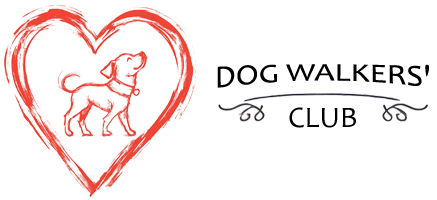The Dog Walker's
Business Growth Formula:
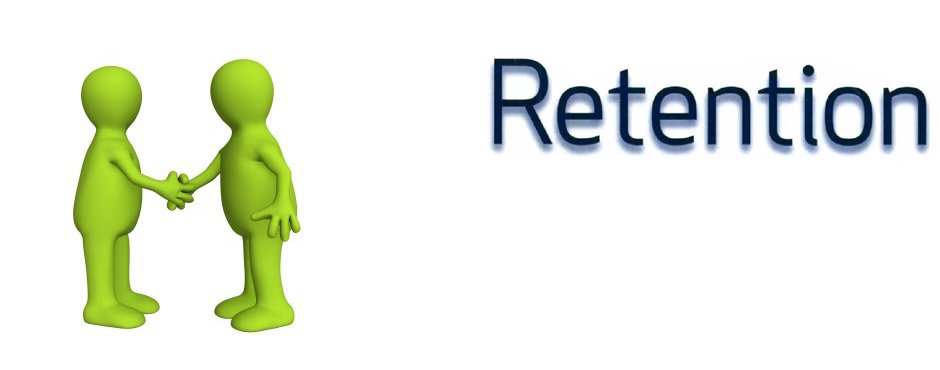
Below is the table of contents - the index - of all the different Retention methods you might like to consider.
This table is interactive. You can click any of the marketing methods to view that section.
It is also a powerful business reference tool, to come back to regularly.
Consider your business. Where is it lacking?
And if you find that your clients are not staying as paying customers for long, then you need to action as many of the "Retention" marketing methods as possible.
(If you're on your phone, turn it sideways to best view this table)
Marketing Method (Click to go to that section)
| Traffic Generation
| Conversion To Sale
| Retention
|
|---|---|---|---|

| |||

| |||

| |||

| |||

| 
| ||

| |||

| 
| ||

| |||

| |||

| 
| ||

|
RETENTION
Loyalty Program

You've seen it before. The Costa Coffee loyalty card where you get your card stamped for every coffee you buy, then you get your 10th free (or whatever their current number is).
Most loyalty cards work on the same principle. Buy some of our product and get the Xth one free.
They work.
Interesting Aside: Recent studies have shown that loyalty is increased when some of the marks on a loyalty card are pre-stamped. In these studies, a 12-mark card with 2 marks pre-stamped (ie 10 empty marks) was more effective at bringing people back to the store than a standard loyalty card with 10 empty marks - because a) people feel closer to the 'end' reward, and b) the reciprocity of being 'given' 2 free stamp marks.
Discount is good. Added value is better.
Beware of training your customers to the discounted price.
Any competitor can compete with discount. Adding value that is unique is hard to copy.
So for a Dog Walker business, a loyalty system might be such that twice a term you hold a special "loyal customers-only" day class where clients can come for extra help or group walks. Or whatever might work for your business, as a loyalty-bonus extra.
Don't be afraid to test new ideas.
The obvious choice is to encourage clients to be pre-paying or signing up to a regular payment system with a recurring billing system.
It helps the clients to pay because it is easier, and it helps you because you get paid automatically. But it might be a good move to reward your customers doing what you want them to do.
Encourage them to pay you automatically.
Could you offer 1 free walk per term, only for subscription payers? Or what else could you offer as a value-add? A longer group walk?
Thank You Cards

Saying "Thank You" goes a long way!
A hand written "Thank you" card, thanking them for their continued business support, how much you love what you do, and that they help you as you help them - will be greatly received - and help the continued custom and business from that client.
Don't believe me? As an example, here are 2 businesses - here and here - that do this hand-written letter writing for clients like John Lewis, BrewDog and GymShark. If they're paying millions for this hand-written service, you can safely assume that it WORKS!
And have a read of this article on the BBC of a billion dollar company grown from writing their own hand written letters here.
You don't need to outsource the writing - do it yourself as a process, for each new client.
Have a process to write a hand written card maybe after a new client has had walk number 1 or 2.
It increases retention.
Christmas cards are also good, when hand-written - but a Thank You card, out of the blue, unexpected is way better.
Also consider a Postcard as a Thank you card. Anything different that gets attention - and is genuine.
You might get your own notelets printed, with your branding and a "Thank you" message on the front.
By way of example, here is a photo of both the notelet and brochure I had made for our luxury dog-friendly family-holiday villa in France...
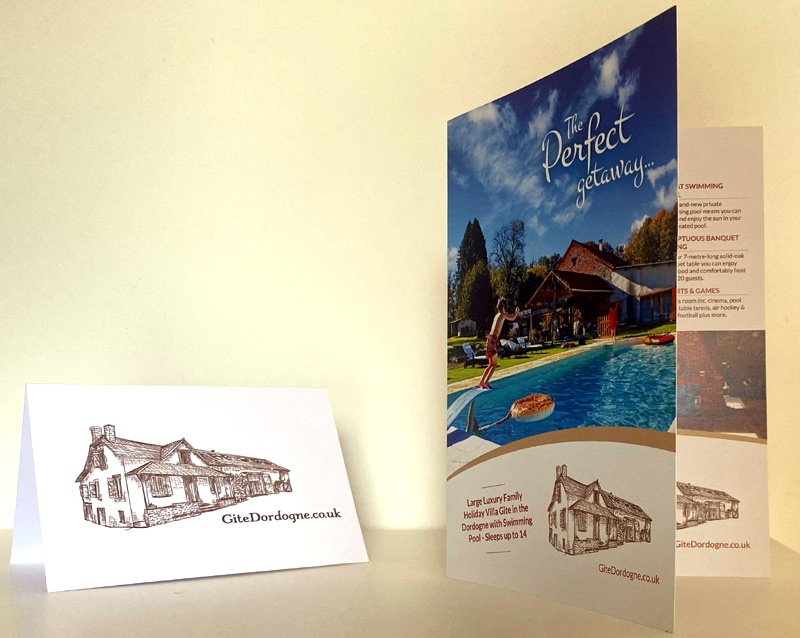
Notelet and brochure that goes to new clients
Both the white notelet and the brochure are printed on luxury-quality heavy / thick card, so the client feels valued.
For every new serious enquiry, I send 3 of the brochures (so they can hand some to family and friends who might be coming on holiday with them, or to help their friends to have their own separate holiday), and the white notelet is hand-written by me, saying "Thank you for your interest", or "Thank you for booking". I usually write a bit more of a message, saying I hope they're looking forward to their holiday, and if they have any questions at all, to contact me.
Also, when they arrive at the villa, there is another personalised hand written notelet (same printed batch) saying
"Hi Katie and family,
I hope you all have a fantastic holiday and get a much deserved break together in the sun. Here is some fresh French bread, some yummy French cheeses and some wines for you to start your holiday. Enjoy!
Speak soon,
Duncan & Esther"
Old school is a good school !
You decide if and when it is right to include your brochure(s) or not.
It is more of a "Thank you" card if you're not also asking them to hand out brochures for you. Test both options.
I normally send the hand-written letter notelet with 3 brochures before they have booked, to serious enquiries, but when they book, I only send the "Thank you for your booking" letter, without the brochures. And on arrival at the villa, the welcome letter notelet is not with brochures.
How and when could you send personalised hand-written letters to your clients?
Which way is the best combo for you?
Feedback & Improvement

Using feedback and improvement serves 2 crucial purposes...
- It helps your business improve, and
- It encourages clients to feel included and therefore important.
This is not asking for a testimonial (where you only want the rosey, positive story. Here, you want the negative.
By getting feedback, you can find out where the niggles and annoyances are with your clients; where you could improve your service.
I like to ask the Magic Wand question;
"If you had magic powers, and a magic wand, what you you add, remove or improve?"
Encourage feedback. Act on the frequent suggestions. Very often as business owners we can't think of everything. But with more and more people, and more and more feedback, we can cover everything that is important.
Imagine you gave some feedback to a business or person, and they thought your idea was clever enough to enact it.
How many people would you tell? You would probably be telling everyone you possibly could, subtly implying how clever you are that they took your advice. Your clients are just the same.
So ask for feedback.
You can use online tools like Survey Monkey. Or simply email your customers and ask them to reply with their feedback.
Using a questionnaire or survey has the advantage that you can more easily compare all the answers, but can put people off. Some people just hate answering surveys. You might have to ethically bribe them to give feedback.
"Give your feedback and enter your chance to win X"
Personally, I find it far more effective to ask them to reply to an email, person-to-person, with their feedback and ideas. Their feedback is more important than the admin-inconvenience if wading through lots of email replies (compared to the simplicity of a survey tool). If you getting feedback from many hundreds of people, then a survey tool might be more practical.
Better yet - speak with them on the phone, and follow up for anything else by email. On the phone, you can really dig in to what they mean and why. Keep digging in to "What would that mean, or improve, to you?"
Either way, make sure the method you use is enticing and intriguing. The wording of your email asking for feedback can do this. Such as...
"Should we have longer walks or smaller? The latest results will be revealed to you after you complete your feedback".
Set Customer Expectations
The quickest way to disappoint is to over-promise

It is always best to under-promise and over-deliver.
Sure, we all have the natural tendency to 'puffery'. To 'big something up' a bit. But tread carefully.
If your clients expect too much, they will be disappointed. And then leave. And probably bad-mouth you to their friends and family.
And that can go a long way, across Facebook and all social media.
So focus on managing expectation. What should they realistically expect in the next few weeks and months? Keep close communication with clients.
Could you give a quick text summary after a walk? "Bella is back home after her walk. She is muddy but happy after a lovely fun walk. She might be a bit sleepy today". You can do this in 15 seconds by dictating into your phone after you have dropped them off.
Those little touches matter.
And keep a few bonuses and extras 'hidden' in the bag, not mentioned, until they have booked their first walk. Like the personalised bandana. Or any other extras you might give.
You want to be able to add an unexpected "wow" after they have booked.
Build Trust Through Relationships

This should most likely happen naturally over time. You should work towards better and better relationships with your clients.
Make sure they see the ongoing benefit of your work. Reinforce the progress their dog is making. Be their friend. Have as many conversations as you can, so they feel they know, like and trust you.
The more they feel you are their trusted friend, and have their best interests at heart, the more likely they are to continue with you.
Implement Anticipatory Service
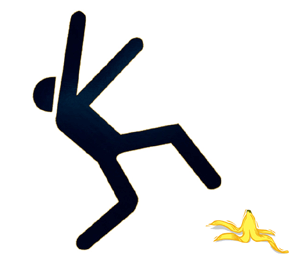
Rather than the old-fashioned process of having a 'customer care' system for problems to be reported, anticipate them in advance and communicate any expected problems.
If you expect some issues and problems, give your clients the heads-up. Tell them before any problem happens.
If the dog is struggling, tell the client.
If you have a pending health problem or operation, or are going to be off work for any reason, tell your clients as early as possible. Help them to make plans for this.
If your business systems or processes have to change, give as much notice as possible.
This all ties in with managing expectation.
Specifically, it is about managing bad news before it happens, rather than waiting for complaints before you act.
Similarly, ask them if there are any problems. Is there anything more you can do?
Reinforce The Sale With Social Proof

Buyer's remorse is a powerful negative force on sales. People buy, then instantly regret it.
Studies show that simply stating "Congratulations, you've made a wise decision" can reduce refunds and cancellations.
The same goes for longer term recurring payments for Dog Walking.
Make them feel like they have made a wise decision, and continue to make a wise decision in buying your dog walking services.
In addition to simply stating "You've made a wise decision", how else can you reinforce the (continued) sale?
Who would you listen to, more than the seller?
Other buyers.
That is called 'social proof' - getting proof of the correct behaviours from social cues. So harvest testimonials from current and past clients, and drip feed them to your other clients, by email, online video, anywhere you can.
A great place to put testimonials is on the order/registration page on your website, and also, on the "Thank you for ordering" page. See the section about getting testimonials, especially video testimonials.
Reduce Pain-Points & Friction

The points in your sales process at which a customer feels pain or is annoyed with your buying process or the process of consuming your offering, are known as pain-points.
Points of confusion or lack of clarity, or ambiguity, that will slow the customer down, are known as friction points.
You want as few points of pain and friction as possible.
Some will be obvious to you, if you simply imagine 'what if I were the customer here?'
Sometimes it is less obvious, but asking for customer feedback will surface the problem.
The Curse of Knowledge
You cant un-know what you already know. That is the curse of knowledge. So it is hard to imagine seeing the situation from the viewpoint of someone who doesn't already know what you know. You already know that your "Buy" button is just over there on your website, or that they need to click the tickbox first - but it might not be obvious to the potential client.
Those are the sort of friction points you need to figure out. Ask a friend, family or neighbour to look at your website or marketing, and see if they can figure out how to buy. And if the messaging makes sense.
Sometimes the pain or friction isn't quite conscious for the customer, but it is affecting sales (or retention). This is when good analytics can come to the rescue. See the section on Google Analytics to learn how to use your website visitor tracking stats to see where any problems may lie.
Usually, once you know what the problem is, the solution is intuitively obvious. If you're not sure, split test using Google Analytics.
Keep asking yourself "How could I make this process more intuitively obvious, easier and more pleasant for the customer?"
Microsoft Clarity
Microsoft Clarity can tell you where people are clicking or not. Use it to reduce pain points and friction.
Use Reciprocity
I have mentioned this a few times previously. Reciprocity is just one of a small number of powerful influence levers.
Robert Cialdini's seminal book "Influence: The Psychology Of Persuasion" outlines the power of six principles that you would do well to understand. I have summarised them for you below (click each to expand)...
- People feel obligated to return favours or concessions. Often with outsized returns. And will more inclined to buy your products after receiving a free benefit or concession (reduced request).
- Example: Free samples increase the chance of purchase.
- Once people commit to something, they're more likely to follow through to stay consistent with that image.
- They are even more likely to commit to that thing, if they stated their commitment publicly.
- Example: Getting someone to agree to a small request first makes them more likely to agree to a larger one later (foot-in-the-door technique).
- Example: Being a follower of yours on Facebook, or giving you a testimonial.
- People look to others' behavior to decide what's correct—especially in uncertain or ambiguous situations.
- Example: "Best-seller" labels or crowded restaurants attract more customers.
- Reviews from other people
- Testimonials
- We're wired to obey legitimate authority figures (real or perceived).
- Example: People are more likely to follow advice from someone wearing a lab coat or with a title like "Doctor."
- We're more easily influenced by people we like or find attractive, or who are similar to us.
Example: Salespeople who mirror customers' body language build trust more easily.
Dress the same way as clients
- Things that are scarce are seen as higher value. Also this couples with social proof - other people must have taken the rest, so it is in demand, so it must be good.
- People want more of what they perceive as rare or in limited supply.
Example: “Only 3 left in stock!” or “Limited-time offer!”

The rule [of reciprocity] says that we should try to repay, in kind, what another person has provided us. By virtue of the reciprocity rule, then, we are obligated to the future repayment of favours, gifts, invitations, and the like
When someone gives us something, society has us ingrained to feel obliged or to feel indebted, to want to return the favour.
Interestingly, scientific experiments show that people return a bigger favour than was originally given them, in order to make sure they fully 'pay off' the indebtedness.
This is why free samples work. Because people feel they have been given something for free, and feel the need to pay off the obligation, by purchasing the product.
You can use reciprocity within your Dog Walking business in any number of ways.
You could give something useful and free every few months, preferably with your Dog Walker business branding on. A free dog bandana one month, a branded poo-bag dispenser another month.
Anything you can give your clients will invoke some element of reciprocity.
Giving a discount is still giving. A 'concession'. So it still invokes reciprocity.
Build Community
If customers feel part of a larger group, they feel more loyalty, and are more inclined to stay as paying customers for longer (source).
Create a community, a 'tribe' that has you as its leader, and a means to communicate.

A tribe is a group of people connected to one another, connected to a leader, and connected to an idea. For millions of years, human beings have been part of one tribe or another. A group needs only two things to be a tribe: a shared interest and a way to communicate.
This concept of a 'tribe' is very deliberately built into The Dog Walkers' Club, to best help you and as many people as possible.
Leadership is the art of giving people a platform for spreading ideas that work.

Be that leader.
Your clients will bond and follow you. And stay.
How?
They have their shared interest, in their love of their dogs, and in you. You need to give them the means to communicate, with you and each other.
There are many ways. Digital is best. You can also use Facebook Groups. You might also create more personal, local connections. A local dog club or meet-up.
Publicise Their Self-Identity

We humans love a shortcut. The quick easy way to X.
The same goes for how our minds work. We make mental leaps of faith. Or we are 'energy efficient' with our brains.
And the fact that we don't (usually) question and re-question our decisions means we don't have to keep making the same decision over and over. Once we have made a commitment, we accept that decision as the shortcut. We don't have to think hard about it anymore. We just remember that decision. Or that behaviour.
Also, good personal consistency is valued in our society. We like people who do what they say they will. So we stay consistent to commitments and decisions we have already made.
And we stay extra-consistent if we 'go public' with the commitment. When the rest of the community or country knows about your decision, you feel more committed than ever.

There are certain conditions that should be present for a commitment to be effective in this way: they should be active, public, effortful and freely chosen.
Once your client feels committed to the decision they made to use you as their Dog Walker, they are far more likely to stick with that decision.
So how can you encourage clients to go public with their commitment / decision to use you as their Dog Walker?
A testimonial is a great option.
It doesn't have to be a statement as obvious as "I decided to use X". The simple appearance in any publicly visible place is enough. A group photo published in your local newspaper or Facebook.
A large branded bandana on their dog will display their commitment to the world. And to themselves.
If your clients all wear your business T-shirts and appear in the local paper, helping out at a local event, this is a public display of that commitment.
Anything or any event or place where your clients can be seen with a doggy bandana branded to you, or anything identifying that they are clients of yours, will serve this purpose.
Car Sticker
Could you have car window stickers made up? "My dog is super-healthy because of [your Dog Walking business name]" and a QR code so people can get to your website.
Or, imagine being sat in traffic behind this car...
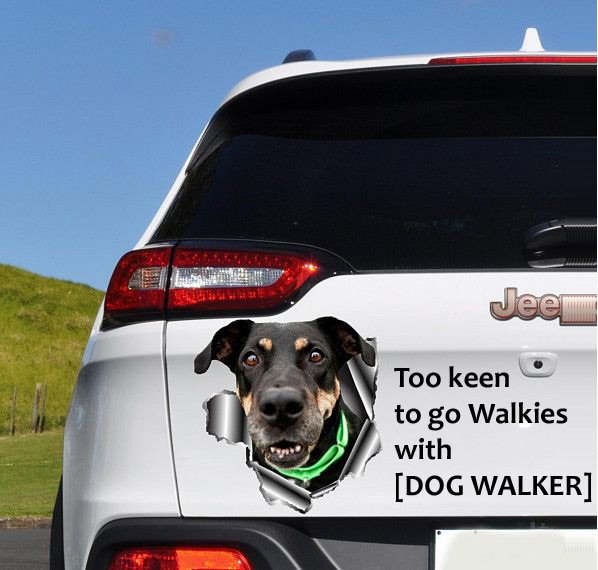
(and include your QR code).
... Or this one...
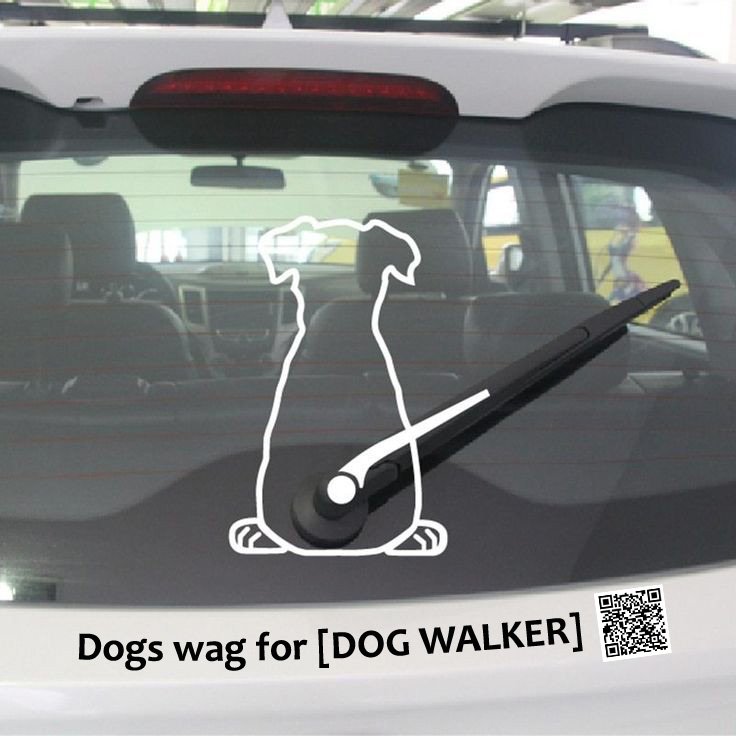
Just some funny, crazy ideas - but you get the concept, right?
The client is helping, and also making a public statement of commitment.
Brochure Handout
You could give each client 5 or 10 brochures or fliers. Ask them to give them to anyone who they happen to talk to about their dog. They will inevitably have conversations with other friends about the Dog Walker they are using. If they can give out a brochure, it serves 2 purposes - to encourage new sales, and for the client to make a more 'public' statement of commitment to you.
Sales retention - continued use of your Dog Walker services - will increase because of all of this.
So that concludes the 'Get more clients' section, ending with this Retention section, of the Dog Walkers' Business Growth Formula.
You have seen a lot of different methods, strategies and tactics to grow your client base, by increasing
- Traffic to your website or business (getting people to you)
- Conversion to sale (getting them to sign up with you), and
- Retention (keeping them as a paying client)
Next, lets look at increasing your average transaction value - making each 'shopping basket' larger...
Feedback & Add-Back
Now that you have read this 'Retention Methods' section, add your comment below with your feedback to answer these 3 questions...
- What was most useful?
- What has proved to be the most successful method within your own business?
- What more do you want to know about?
(Scroll below comments for links to the next section)
The rest of this Business Growth Formula is as follows;
Introduction & Marketing Theory <<
- Increase your client base: To read the detailed methods for getting new potential clients, converting them to paying customers, and keeping them...
- Click here to read the Online methods <<
- Click here to read the Offline methods <<
- Click here to read the pure Retention methods << - Increase your average transaction value
- Click here for details << << NEXT - Increase the frequency of repeat purchases
- Click here for details <<
